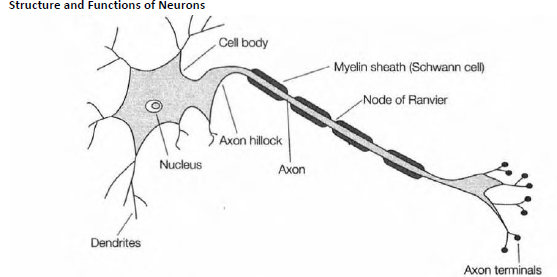
There are two classes of cells in the nervous system; the neuron and neuroglial cell (glia). The neuron is the basic functional unit of the nervous system. The average vertebrate nervous system contains about 10 billion neurons. Glial cells play largely a structural role by providing firmness and structure for the central nervous system. They do not produce action potential. They support and protect neurons, and participate in neuron nutrition and the defense processes of the central nervous system.
-A typical neuron has four morphologically defined regions; the dendrite, the cell body (soma, perikaryon), axon, presynaptic terminal.
i)he dendrites are responsible for receiving signals from the environment, sensory epithelial cells or other neurons.
The cell bodies are responsible for integrating the signals.
ii)The axons transmit action potential impulses some distance along their length before signaling an adjacent cell at the pre-synaptic terminal. The axon is a tubular process that is often long (over 1 meter in large animals). It is the conducting unit of the neuron. Axons branch near their ends into several specialized endings called pre-synaptic terminals.
iii)The pre-synaptic terminals transmit a chemical signal to an adjacent cell, usually another nerve cell or a muscle cell. The site of contact with the adjacent cell is called a synapse. It is formed by the pre-synaptic terminal of one cell, the receptive surface of the adjacent cell and the space between the two cells, the synaptic cleft.
iv) Pre-synaptic terminals contain synaptic vesicles that contain a chemical transmitter before its release into the synaptic cleft
Most axons are coated with a layered insulating myelin sheath which speeds the transmission of signals. The myelin sheath is punctuated along its length by gaps called nodes of Ranvier, which help this process. Because the myelin sheath is non conductive, ion exchange (depolarization) only occurs at a node, and signals leap from node to node along the length of the axon. This type of conduction is called saltatory conduction.
This mechanism increases the velocity of nerve transmission in myelinated fibres an average of 5 to 7-fold. Saltatory conduction also conserves energy for the axon, for only the nodes depolarize.
When a neuron transmits an electrical impulse, a chemical called neurotransmitter is released at synapses. This neurotransmitter may make a muscle cell contract, cause an endocrine gland to release a hormone, or affect an adjacent neuron
marto answered the question on
April 16, 2019 at 07:27